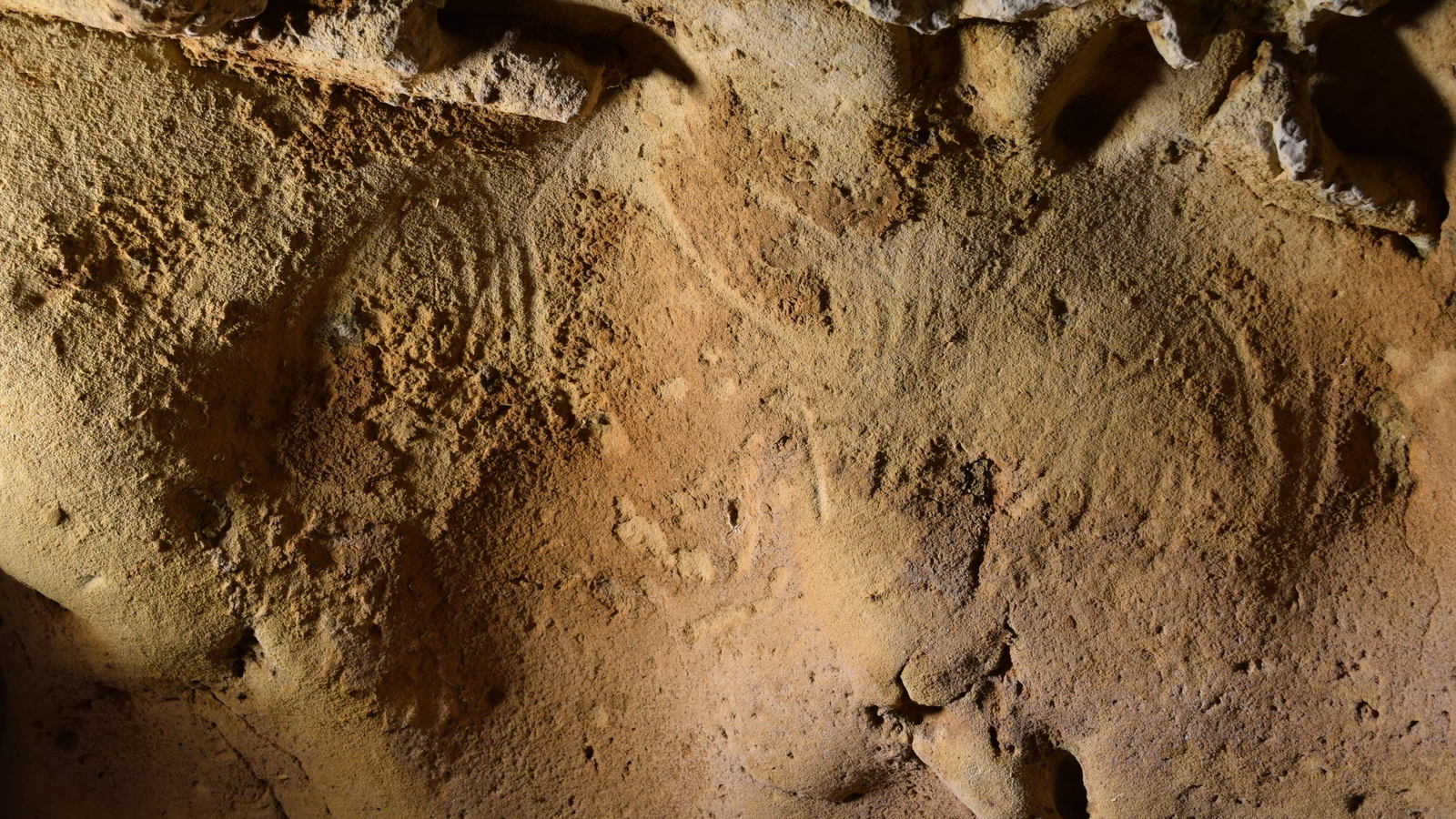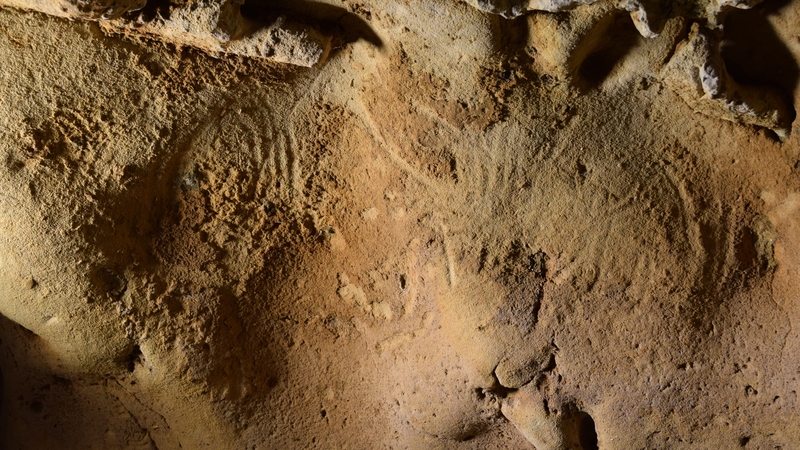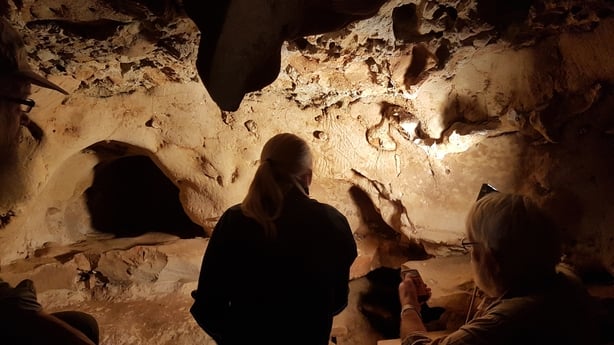Melodi
Disaster Cat
Another Neanderthal's are people too, but an interesting one. This cave was four 15 years ago when that idea was not acceptable. Now it is being recognized as Neanderthal art. Simple art, sure, but basic finger painting is still art. I'd also like to point out that basic circles and dots are also common in later cave art, usually found between or on top of the animals. It did mean something. We don't know what. But then we don't know what many ancient symbols still used meant, including things like the Celtic Trisqulion pattern—Melodi (image included because it is the article's topic}.

 www.rte.ie
www.rte.ie

The engravings discovered in the Roche-Cotard cave in Loire, France
Finger markings discovered inside a cave in France are "organised and intentional" and were likely made by Neanderthals more than 57,000 years ago, scientists have said.
Thought to be the oldest known engravings made by the extinct human relative, the marks were found on La Roche-Cotard cave walls in the Centre-Val de Loire region of northern France.
The researchers said their findings, published in the journal Plos One, add to evidence that Neanderthals were "complex and diverse as those of our own ancestors".
The authors wrote: "Fifteen years after the resumption of excavations at the La Roche-Cotard site, the engravings have been dated to over 57,000 years ago… making this the oldest decorated cave in France, if not Europe."
For the study, Jean-Claude Marquet, of the University of Tours in France, and his colleagues analysed the wall markings, also known as finger flutings.
The team created 3D models of the engravings and compared them with known human markings.
The researchers concluded that the wall markings were deliberate, based on their shape, spacing, and arrangement.

The finger markings are organised and intentional and thought to be the oldest known engravings by Neanderthals more than 57,000 years ago
The types of markings found were circular, dotted, triangular and wavy.
The organised and intentional shapes may be symbolic creations, according to the researchers, although they added: "It is not possible for us to establish if they represent symbolic thinking."
"Nevertheless," the authors wrote, "Our understanding of the relationship between Neanderthals and the symbolic and even aesthetic realms has undergone a significant transformation over the past two decades and the traces preserved in the cave of La Roche-Cotard make a new and very important contribution to our knowledge of Neanderthal behaviour."
The team also dated cave sediments and concluded that La Roche-Cotard cave became closed off by infilling sediment around 57,000 years ago, long before modern humans became established in the region.
The markings, along with stone tools found in the cave, provide "strong evidence that these engravings are the work of Neanderthals", the researchers said.
The authors said the wall engravings pay "tribute to this lost humanity, whose role in the biological and cultural evolution of humans is undergoing profound revision".
They wrote: "In terms of culture, we now have a better understanding of the plurality of Neanderthal activities, attesting to elaborate and organised social behaviours that show no obvious differences from those of their contemporaries, anatomically modern humans, south of the Mediterranean."

Ancient Neanderthal wall art discovered in French cave
Finger markings discovered inside a cave in France are "organised and intentional" and were likely made by Neanderthals more than 57,000 years ago, scientists have said.
Ancient Neanderthal wall art discovered in French cave
Updated / Thursday, 22 Jun 2023 07:38
The engravings discovered in the Roche-Cotard cave in Loire, France
Finger markings discovered inside a cave in France are "organised and intentional" and were likely made by Neanderthals more than 57,000 years ago, scientists have said.
Thought to be the oldest known engravings made by the extinct human relative, the marks were found on La Roche-Cotard cave walls in the Centre-Val de Loire region of northern France.
The researchers said their findings, published in the journal Plos One, add to evidence that Neanderthals were "complex and diverse as those of our own ancestors".
The authors wrote: "Fifteen years after the resumption of excavations at the La Roche-Cotard site, the engravings have been dated to over 57,000 years ago… making this the oldest decorated cave in France, if not Europe."
For the study, Jean-Claude Marquet, of the University of Tours in France, and his colleagues analysed the wall markings, also known as finger flutings.
The team created 3D models of the engravings and compared them with known human markings.
The researchers concluded that the wall markings were deliberate, based on their shape, spacing, and arrangement.

The finger markings are organised and intentional and thought to be the oldest known engravings by Neanderthals more than 57,000 years ago
The types of markings found were circular, dotted, triangular and wavy.
The organised and intentional shapes may be symbolic creations, according to the researchers, although they added: "It is not possible for us to establish if they represent symbolic thinking."
"Nevertheless," the authors wrote, "Our understanding of the relationship between Neanderthals and the symbolic and even aesthetic realms has undergone a significant transformation over the past two decades and the traces preserved in the cave of La Roche-Cotard make a new and very important contribution to our knowledge of Neanderthal behaviour."
The team also dated cave sediments and concluded that La Roche-Cotard cave became closed off by infilling sediment around 57,000 years ago, long before modern humans became established in the region.
The markings, along with stone tools found in the cave, provide "strong evidence that these engravings are the work of Neanderthals", the researchers said.
The authors said the wall engravings pay "tribute to this lost humanity, whose role in the biological and cultural evolution of humans is undergoing profound revision".
They wrote: "In terms of culture, we now have a better understanding of the plurality of Neanderthal activities, attesting to elaborate and organised social behaviours that show no obvious differences from those of their contemporaries, anatomically modern humans, south of the Mediterranean."

